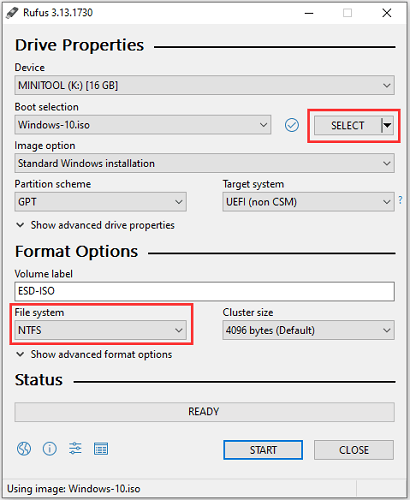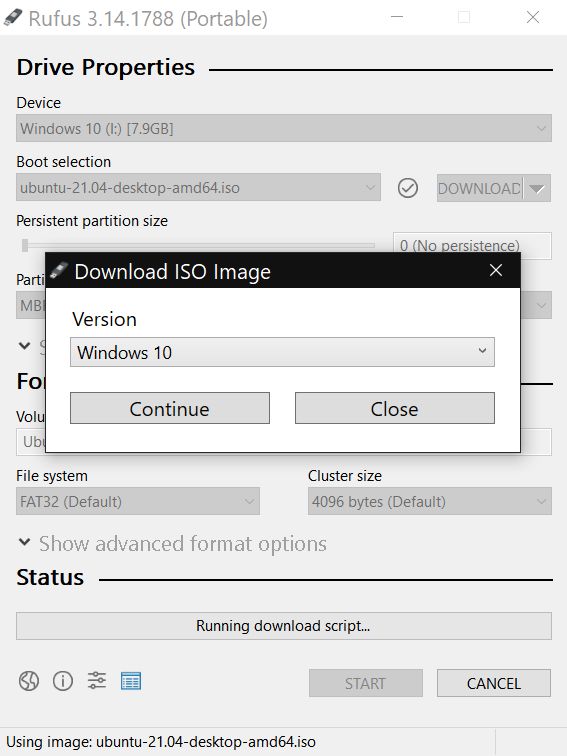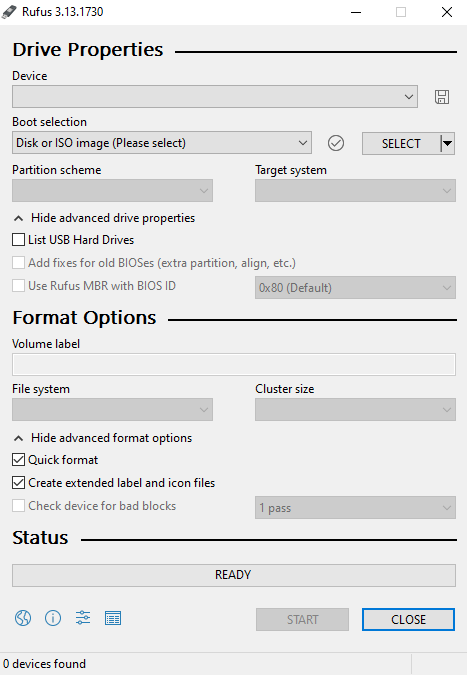

So you usually cannot take the boot loader from an ISO file (which would usually be an El Torito boot loader), copy it to USB media, and expect it to boot. Unfortunately, HDD/USB and ISO boot loaders are very different beasts, and the BIOS or UEFI firmware also treats USB and optical media very differently during the boot up process.
Rufus iso image code#
Then there is the actual boot loader itself, the first bit of code that executes when a computer boots from USB media. But of course that means that, whoever created the ISO system must have made some provisions to support FAT32 or NTFS as a file system for live use or installation (which not all people, especially the ones who rely a bit too much on ISOHybrid, tend to do). Most of the time, this means extracting and copying all of the files from the ISO file onto a FAT32 or NTFS file system, which is what bootable USB flash drives tend to use. One of the first things that usually needs to go is the ISO9660 or UDF file system that ISO files use. How does that relate to the list of options? We are coming to that. But that also means that some conversion must (usually) occur so that our round ISO peg can fit nicely into the smaller “USB media” square hole. This is why providers tend to want to stick with ISO files where possible, as it (usually) provides a better user experience across all operating systems.
Rufus iso image windows#
Once the bootable USB media has been created, Windows will not be able to access any content on it until you reformat it. For instance, this will be the case if you use FreeBSD USB images on Windows. That means that even after you create your bootable USB media, you may not be able to actually see any content on it until you boot it up. Well, outside of historical reasons, one of the issues with DD Images is that because they are a partitioned file system, if you create a 1:1 copy on USB media that is larger than the one used by the person who created the image, then you will end up with the apparent “capacity” of your USB media reduced to the size of the one used in creating the original DD Image.Īlso, whereas optical discs and therefore ISO files can only ever use one of two file systems (ISO9660 or UDF), both of which have been very well supported in all major operating systems for a very long time (and allows you to take a peek at the image content before or after you use it), DD Images can literally use any of the thousands of different file systems that exist. Now you may be wondering, if ISO files are so poorly suited for creating bootable USB media, why are most operating system distributors out there providing ISO files instead of DD Images. Thus, we have established that ISO files are actually poorly suited to create bootable USB media because they are the equivalent of providing a round peg to fit a smaller square hole, and therefore, the round peg must be altered to fit it. For the record, in Rufus terminology, a 1:1 copy on USB media is called a DD Image (you can see that option in the list) and some distributions, like FreeBSD or Raspbian, actually provide DD Images for USB installation, alongside ISO files for CD/DVD burning. That is not to say that this kind of 1:1 copying cannot exist on USB media, just that 1:1 copies on USB media will be completely different from 1:1 copies on optical discs and are therefore not interchangeable (outside of using ISOHybrid images that are crafted to work as 1:1 copies on USB and optical media both). So, if you have an ISO file, you simply cannot do with USB media what you can do with an optical disc, which is read from every single byte of the ISO file and copied as is, in sequence, onto the disc (what CD/DVD burner applications do when “working” with ISO files). An ISO file is a 1:1 copy of an optical disc, and optical disc media are very different from USB media, both in terms of how their boot loaders should be structured, what file system they use, how they are partitioned (they are not), and so on. To start with, you have to understand that the ISO format was never designed for USB booting.

First of all, a lot of the options you mention are only listed when running Rufus in Advanced Mode (when the Advanced Options Section is displayed), because they are intended for people who already know what they are for. SuperUser contributor Akeo has the answer for us: Why is creating a bootable USB drive more complex than creating bootable CDs? The Answer Could someone explain the difference between the two and maybe give a brief overview of the different options?

Now when it comes to USB drives, you have lots of options. SuperUser reader William wants to know why creating a bootable USB drive is more complex than creating bootable CDs:Ĭreating a bootable CD is really simple in my opinion, all you need to do is burn an ISO file to a disc and it is bootable.


 0 kommentar(er)
0 kommentar(er)
